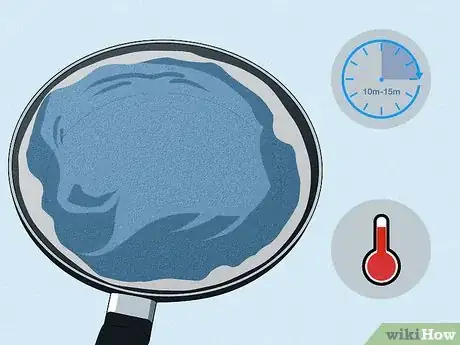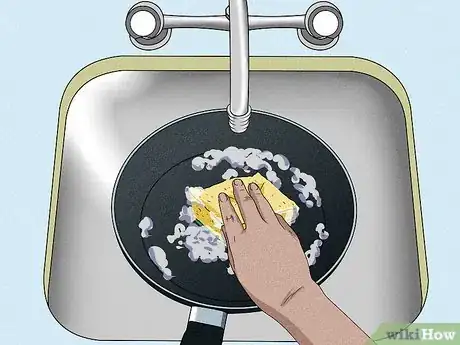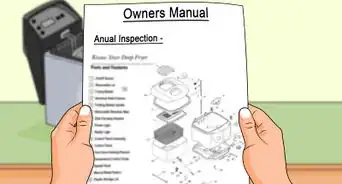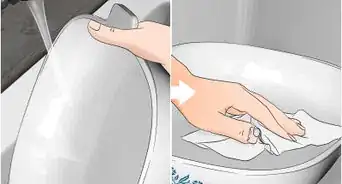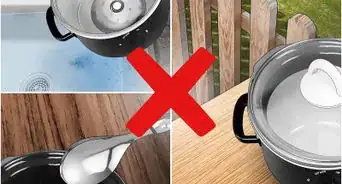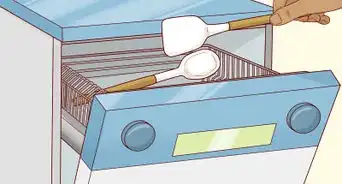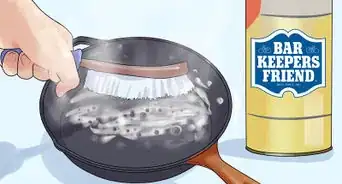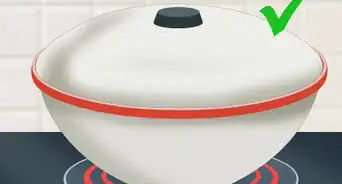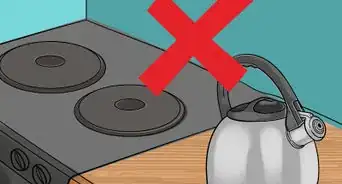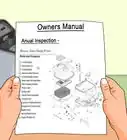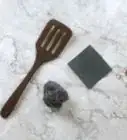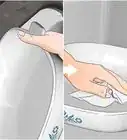This article was co-authored by wikiHow Staff. Our trained team of editors and researchers validate articles for accuracy and comprehensiveness. wikiHow's Content Management Team carefully monitors the work from our editorial staff to ensure that each article is backed by trusted research and meets our high quality standards.
This article has been viewed 59,183 times.
Learn more...
High-performance nonstick cookware like Calphalon can be a lifesaver in the kitchen, but after the meal has been devoured it still needs to be washed. Fortunately, Calphalon’s hard-anodized aluminum finish makes it a breeze to wipe clean even the most stubborn stuck-on residue. Simply scrub your pots and pans by hand using a mild liquid dish soap and a soft sponge, then rinse them and leave them to dry. By caring for your Calphalon cookware properly, you can ensure that it will provide you with an unparalleled cooking experience for years to come.
Steps
Handwashing Calphalon Cookware
-
1Rinse the cookware with warm water. Hold dirty pots and pans under the stream and swish the water around inside. The heat and pressure of the water will help dislodge food particles clinging to the surface of the cookware. Try to rinse away as much stuck-on food as you can before you begin scrubbing.
- Cold water can lower the temperature of the cooking surface too quickly, potentially warping or weakening a piece of cookware.[1]
-
2Wash the cooking surface by hand. Though some Calphalon products are technically dishwasher safe, it’s always preferable to hand wash nonstick surfaces to preserve their carefully tempered finish and luster. This will allow you to spot clean cookware and give it more delicate treatment.[2]
- Go over the manufacturer’s recommendations for cleaning and caring for a particular piece of cookware.
- Protecting the finish of your nonstick cookware is key to extending its lifespan.
Advertisement -
3Use gentle soaps and scrubbers. A mild liquid detergent like Dawn or Palmolive will work best, as these soaps don’t contain any harsh chemicals or astringent agents that might cause scratches. Along with liquid dish soap, you should scrub your Calphalon pots and pans with a non-abrasive sponge or soft-bristled dish brush.[3]
- For an extra soft touch, a simple washcloth will also get the job done.
- Stay away from steel wool, metallic brushes and anything else likely to ruin a piece’s finish.
-
4Soak stubborn food stains to soften them. If your pots and pans are crusted with burnt or stuck-on residue, they may need a little extra treatment. Soaking the cookware will help the anodized aluminum release hardened food particles without the need for forceful scouring. Use hot water and leave the cookware to sit for 10-15 minutes, then hand wash as normal.[4]
- For best results, add about a cup of distilled white vinegar to the bottom of the pots and pans before you soak them.
- Because of their resilient finish, Calphalon pieces won’t require as much soaking as ordinary pots and pans.
-
5Rinse the clean cookware thoroughly. After soaking and scrubbing your pots and pans, be sure to wash away all traces of food and soap. Otherwise, these substances may dry on the cooking surface, creating an unsightly film. Shake off excess water and find a good place to hang or lay out the cookware to begin drying.[5]
- If any remnants of food or oil remain in the piece after rinsing, it may be necessary to repeat the cleaning process.
-
6Allow cookware to dry completely. Pat your cookware dry with a clean, absorbent towel. You can also rest pots and pans upside down and leave them to air dry. Keep your cookware in a well-ventilated, open area while it dries to speed to process along. Afterwards, your Calphalon cookware will be as good as new![6]
- Don’t put away wet pots and pans with the lids on them, as this could potentially cause them to smell.
- Stash Calphalon pieces in a vertical dish rack to help them drain while they dry.
Caring for Your Cookware
-
1Allow the cooking surface to cool before washing. Give your cookware several minutes to return to a normal temperature. If you submerge a hot pan in cold water, it may cause the material to permanently warp or bubble.[7]
- Always use warm or hot water to clean your Calphalon cookware.
- Exposing heated cookware to cold water against the manufacturer’s instructions may void your product warranty.
-
2Handle Calphalon with care. Though Calphalon is scratch-resistant and made to take a beating, too much consistent wear and tear can render its nonstick finish ineffective. Avoid dropping, banging or being overly rough with your cookware. If you take care of it, it’s guaranteed to last you a long time.
- Whenever possible, use plastic utensils instead of metal ones to prevent scratches.[8]
- Never attempt to cut ingredients while they’re inside the pan.
-
3Polish pots and pans with a special cleanser. If your cookware starts looking dull after repeated use, a product like Calphalon Dormond Cleanser or Bar Keepers Friend can restore the finish to its original condition. These types of cleansers are formulated specifically for use on stainless steel and other nonstick surfaces, and can be useful for renewing smoothness and shine.[9]
- Nonstick cleansers and polishes can leave behind a powdery residue if they’re not rinsed away completely.[10]
-
4Buff out small scratches. Buffing can improve the appearance of pieces that have just begun to display tell-tale silvery scratch lines. Using a heavy-duty Scotch-Brite scrubbing pad, rub the area around the scratch with a light circular motion until the worst of the damage disappears. Afterwards, treat the piece with a special nonstick cleanser and rinse it thoroughly.[11]
- Rub along the grain of the pan to avoid causing further scratching or scuffing.
- Severely scratched cookware should be thrown out and replaced. When nonstick surfaces become damaged, it’s possible for them to release toxic chemicals that can leach into food.[12]
Community Q&A
-
QuestionDo I need to season my nonstick pan?
 Community AnswerOnly cast iron pans need seasoning. Nonstick, depending on the type, will sometimes contribute an off flavor the first few times you use it.
Community AnswerOnly cast iron pans need seasoning. Nonstick, depending on the type, will sometimes contribute an off flavor the first few times you use it.
Warnings
- Never use bleach, ammonia, baking soda or any other harsh household cleaners to clean Calphalon cookware. This is almost certain to cause irreparable damage.⧼thumbs_response⧽
Things You'll Need
- Calphalon nonstick cookware
- Warm water
- Mild liquid dish soap
- Non-abrasive sponge or soft-bristled dish brush
- Calphalon Dormond Cleanser or Bar Keepers Friend
- Scotch-Brite scrubbing pad
- Clean, dry towel
- Distilled white vinegar (optional)
- Drying rack (optional)
References
- ↑ http://www.calphalon.com/en-US/use-and-care-calphalon-signature-stainless-steel
- ↑ https://www.youtube.com/watch?v=OQXn-XOpO5U
- ↑ http://www.calphalon.com/en-US/use-and-care-calphalon-signature-stainless-steel
- ↑ https://www.youtube.com/watch?v=DPLVN8CFhbM
- ↑ https://www.youtube.com/watch?v=OQXn-XOpO5U
- ↑ http://www.ebay.com/gds/How-to-Clean-Calphalon-/10000000205601222/g.html
- ↑ http://www.calphalon.com/en-US/use-and-care-calphalon-signature-stainless-steel
- ↑ https://delishably.com/cooking-equipment/How-to-Take-Care-of-Your-Non-Stick-Frying-Pan
- ↑ https://www.youtube.com/watch?v=OQXn-XOpO5U



